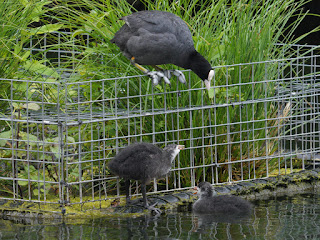The Great Crested Grebes at the north end of the Long Water are nesting again. You can see the sitting bird in the reeds. Their chick is still being fed, and will be for some time, but it will have to grow up fast when the new chicks are hatched. It is already beginning to try fishing for itself, though probably not catching anything yet. Luckily there are lots of small fish in the lake now.
Thanks to Virginia for this lovely picture of the grebes in the middle of the Long Water with their two chicks.
The single chick at the south end, by the bridge, looked out from its father's back.
The three Coot chicks at Peter Pan are now quite large and looking much more attractive, at least to human eyes.
There are two slightly younger ones from a nest between the wire baskets on the Serpentine island.
The recent warm weather has caused a considerable growth of algae in the Long Water, annoying the park staff but delighting the Mute Swan family who think it's delicious.
A very young Greylag gosling rested in the middle of the path, ignoring passing humans. But if a dog appeared, even in the far distance, its mother would call frantically to get it into the water.
The brood of ten are growing up fast.
The two pairs with two goslings each are always together, which is unusual for Greylags (unlike Canadas, where mothers get together and even look after each other's goslings). Perhaps the two mothers are sisters. Geese retain family attachments all their life.
The Red-Crested Pochard with the faded head was at the Vista.
A Herring Gull on the edge of the Serpentine used its powerful beak to break open a crayfish it had just caught.
One of the adult Magpies in the family that nested near the Triangle car park has a short tail. Probably the feathers got broken during nesting. It will have to wait till the nest moult before it gets back to normal.
A Great Tit bathed in a puddle in the Flower Walk.
I was surprised by a Coal Tit here which came to take food from my hand. Perhaps it is the very confident one usually found between the Albert Memorial and the West Carriage Drive. Coal Tits are quite mobile, and if you feed them they may follow you for several hundred yards. Thanks to Neil for this picture of it.
The wildflower patch in the Rose Garden is in full bloom with poppies, cornflowers and oxeye daisies.
But the Honeybees are going for purple flowers at the moment, such as lavender ...
... and cranesbill.












I wonder how they see the purple colour in those flowers. They see things we can't.
ReplyDeleteIt's s lovely thought, to think that the Coal Tit should have followed you for such a distance.
I could melt with the Grebe pictures.
I think that both these purple flower have ultraviolet markings on them in the form of lines radiating from the centre along each petal, like a five-pointed asterisk. This gives the bee an aiming point, in the same was as the H on a helicopter landing pad.
Delete